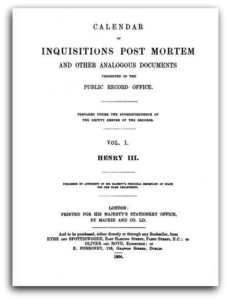
An invaluable source for English genealogists, published abstracts of inquisitions post mortem not only identify heirs but often from whom the deceased inherited land.
By William R. Gann*
Adapted from The Gann Gazette, Vol. 5, No. 4
Reprinted with permission of the author
A man named John Gann died on 22 January 1526/27, in the county of Lincolnshire, England. After his death, an inquisition post mortem taken.
An inquisition post mortem is not the same as a coroner’s inquest, or the medical post mortem carried out after a suspicious death. In reality, a post mortem (Latin term meaning “after death”) is a local inquiry into the lands (real estate) held by people of some status or social or financial standing. The purpose was to discover what income and legal rights were due to the Crown (the King). In other words, what property was held by the deceased, which might belong to the King.
Inquisitions were held only when it was thought or known that the deceased held lands which belonged to the Crown. These records of post mortems are of value to the family researcher since the evidence presented in the inquiry gives the name of the property or holdings of the deceased. Next, the name and age of an heir are given, if there were one. Since this was in effect, the eldest male was in line to automatically receive all property of the father. If the heir was male, then he received all of the lands. If the heirs were daughters, then the land was divided among them regardless of their ages. When the heirs were under age, the King took possession of the lands until the heir(s) came of age. Sometimes a proof of age was recorded in a separate inquiry of inquisition. Widows also had rights of dower in the lands, which continued long after the death of their husbands, and there are inquisitions into this as well. These different actions are usually recorded as part of the inquisition post mortem.
After the death of John Gann, an inquisition was taken at Sleford in the county of Lincolnshire “of the fifth day of the month of November in the eighteenth year of the reign of King Henry VIII” [1516—1517]. Robert Hussey, esquire, Escheator of the King, served as judge of the inquiry. From testimony of several witnesses, they named a certain Thomas Gann, chaplain, and others who were “seized of” (possessed) one messuage (dwelling house) and twelve and one-half acres of arable land in the town and fields of Stowe, a few miles northwest of the modern day city of Lincoln. And in addition, they also held one messuage and fifteen acres of arable land and meadow in Stowe and Barham (Barholme) in the county of Lincolnshire for the use of the aforesaid John Gann, his heirs and assigns.
When John Gann died, he personally was seized of four messuages in Brune in the county of Lincolnshire. The witnesses further stated that John Gann neither had nor held any additional land. The inquisition also said John Gann had a son, William Gann, who was his next heir and was of the age of 21 and more.
____________
*William R. Gann, a retired educator, served as editor of the Missouri State Genealogical Association’s Newsletter and Journal. He and Gary R. Toms co-authored a narrative history, The Ignatious Nathan Gann Family: Three Generations of Pioneers.
